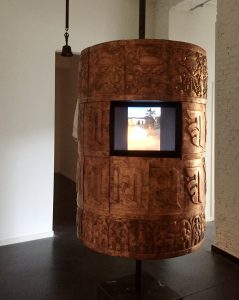 An unflinching examination of the politics of protest in Tibet, confronting new audiences with the anguish of self-immolations in Tibet, is currently a part of an international art Bienniale in Belgium on the theme of justice, until May 21.
An unflinching examination of the politics of protest in Tibet, confronting new audiences with the anguish of self-immolations in Tibet, is currently a part of an international art Bienniale in Belgium on the theme of justice, until May 21.
The last testimonies of self-immolators, smartphone videos, portraits and Tarkovsky-like official footage are brought together by film-making duo Tenzin Sonam and Ritu Sarin to shattering effect in ‘Burning against the Dying of the Light’ at the Contour 8 Bienniale.
Tenzin and Ritu, a film-making duo based in Dharamsala, India, frame the self-immolations within the context of the worldview of Tibetan Buddhism – “as do the self-immolators themselves” – and the stark threat to the survival of Tibet as a civilization, a sovereign and distinct entity. They write that the work “attempts to locate this unprecedented and dramatic expansion of dissent within a historical continuum that has its roots in the occupation and colonization of Tibet under Chinese rule six decades ago.”
At the heart of the exhibition, a prayer wheel slowly turns, adorned with a single khatag and tolling a bell, its ring intended to dispel ignorance. Unlike a typical Buddhist prayer wheel, it consists of its bare armature, ringed by metal bars with rolls of religious text exposed at its centre. Embedded within it is a video screen showing footage of self-immolations shot on camera-phones in close, unsparing detail by witnesses whose names we will never know, and who may have been thrown into prison as a result.
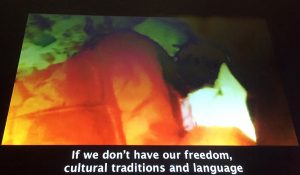 In ‘Two Friends’, a single channel video depicts 22-year old former monk, Ngawang Norphel, blackened almost beyond recognition as a human being, speaking on camera to monks who are tending him after his self-immolation.
In ‘Two Friends’, a single channel video depicts 22-year old former monk, Ngawang Norphel, blackened almost beyond recognition as a human being, speaking on camera to monks who are tending him after his self-immolation.
“When we hear of a self-immolator, we pray that he or she has died,” says one Tibetan friend. The video of Ngawang Norphel, lying covered in an orange quilt in the monastery, is utterly harrowing. Struggling to form words, he asks the monks more than once of the fate of his friend Tenzin Khedup, 24, who set fire to himself at the same time and died. In an unbearably poignant exchange, Ngawang Norphel asks whether his friend has died, and the monks reassure him that: “Tenzin Khedup is fine. He is home.” “Is he dead?” “He is not dead.” Ngawang Norphel survived for several more weeks before dying in a Chinese hospital.
Many Tibetans who have self-immolated have sought to underline the religious context of their acts, or have sought to be close to monks with the belief that the appropriate prayers will then be offered after their death by fire. Some have died with their hands clasped in prayer, while many of those who have self-immolated have done so beside a stupa, monastery or nunnery. Others have self-immolated during important prayer ceremonies. Overwhelmingly, Tibetans who have set fire to themselves and who have risked their lives in peaceful protest have called for the Dalai Lama to be allowed to return to Tibet.
Lines from the famous letter by Thich Nhat Hanh to Martin Luther King in Ritu and Tenzin’s exhibition further illuminate the sacrifice of those individuals burning their bodies: “A man who burns himself too much must die. The importance is not to take one’s life, but to burn. What he really aims at is the expression of his will and determination, not death. In the Buddhist belief, life is not confined to a period of 60 or 80 or 100 years: life is eternal. Life is not confined to the body; life is universal. To express will by burning oneself, therefore, is not to commit an act of destruction but to perform an act of construction, ie to suffer and to die for the sake of one’s people.”
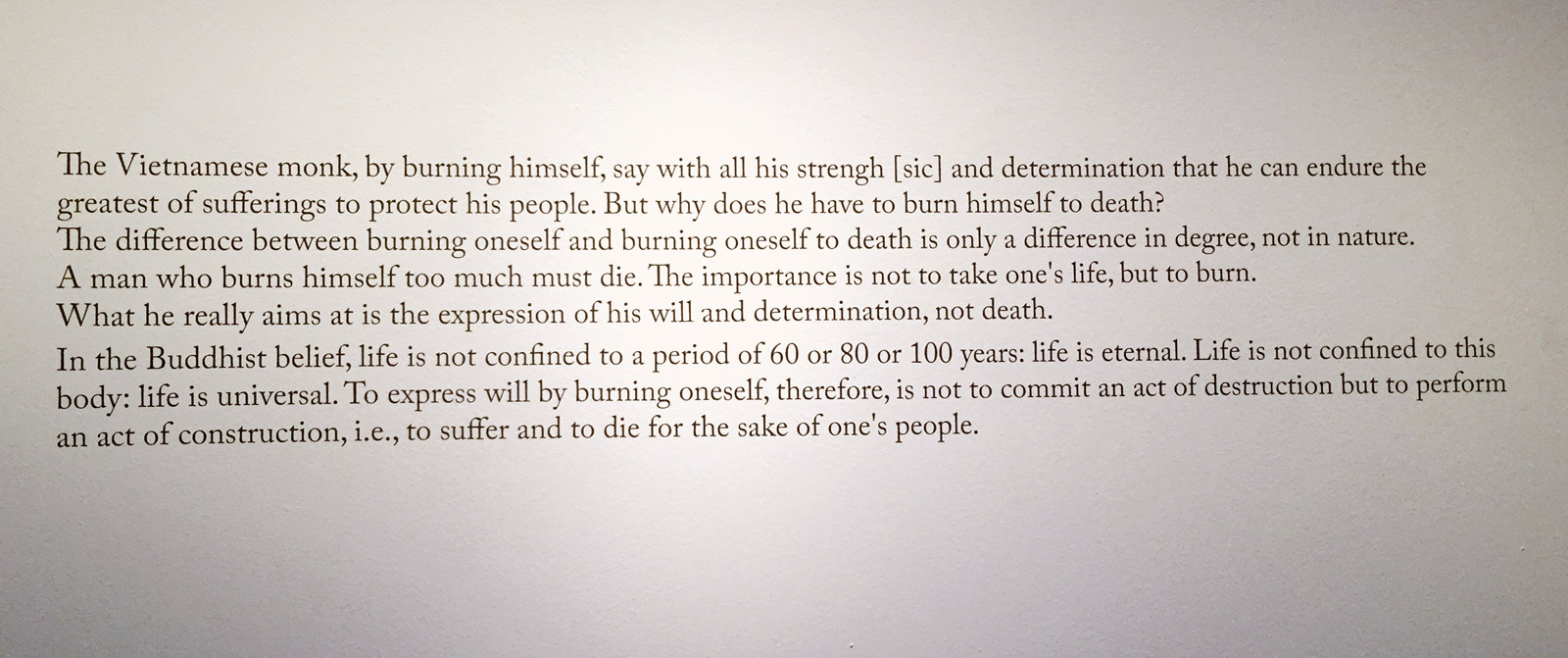
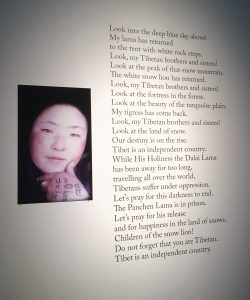 On the wall, lines from a poem left by 17-year old nun Sangye Dolma, whose luminous and beautiful face appears here more as a classical painting than selfie, reveal a message of hope beyond despair. Like many of those who set themselves on fire in Tibet, it is not addressed to the U.N., the international community but to fellow Tibetans, written in solidarity, and urging them to “Look my Tibetan brothers and sisters! Look at the land of the snow. Our destiny is on the rise. […] Children of the snow lion! Do not forget that you are Tibetan. Tibet is an independent country.”
On the wall, lines from a poem left by 17-year old nun Sangye Dolma, whose luminous and beautiful face appears here more as a classical painting than selfie, reveal a message of hope beyond despair. Like many of those who set themselves on fire in Tibet, it is not addressed to the U.N., the international community but to fellow Tibetans, written in solidarity, and urging them to “Look my Tibetan brothers and sisters! Look at the land of the snow. Our destiny is on the rise. […] Children of the snow lion! Do not forget that you are Tibetan. Tibet is an independent country.”
Tenzin and Ritu, whose feature films and documentaries include ‘Dreaming Lhasa’ and ‘The Sun Behind the Clouds’ (http://whitecranefilms.com/), have also created a 25-minute film, Drapchi Elegy. It tells the story of Namdrol Lhamo, one of the 14 ‘singing nuns’ imprisoned in the notorious Drapchi prison in Lhasa in the early 1990s for peacefully demonstrating against Chinese occupation and rule. This deeply poignant film, showing Namdrol at work in an elderly people’s home, and at home in Belgium, “reflects on the loneliness of political exile, and on the direct progression of the Tibetan freedom struggle, from the defiance of the nuns in the 1990s to the sacrifice of the self-immolators 20 years later.”
Remembering her time in prison, Namdrol weeps as she remembers the remarkable solidarity that exists, and continues to exist today in exile, between her sisters in prison – “We used to comfort each other – when we were doing this, or singing silly songs, we were happy”. You can see the film at: http://www.ibraaz.org/channel/164
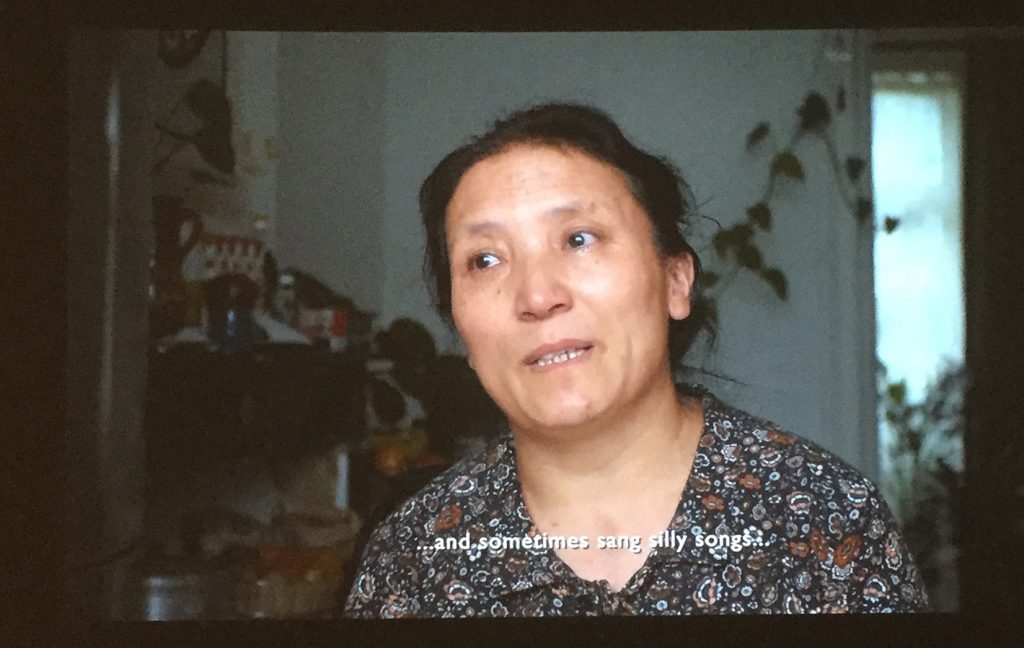
‘Burning against the Dying of the Light’ is on display in the historic town of Mechelen, half an hour by train from Brussels, until May 21. Contour Biennale 8, with its theme this year of ‘Polyphonic Worlds: Justice as Medium’ is symbolically sited in the grounds of the Great Council, established in Mechelen during the 15th Century for law to be enacted across Dutch, German and French territories. Consistent with the theme, other works include the transformation of the wine cellar of a 15th century manor once owned by the city’s watchmakers into an underwater oceanic zone reflecting on ideas of ecological solidarity. In the House of the Great Salmon, originally owned by a monastery for lepers, the Karrabing Film Collective looks at barriers for indigenous people – racialised and colonized incarceration, poverty and securitization.
‘Burning against the Dying of the Light’ compels new audiences unfamiliar with the Tibet story to confront the self-immolation protests in Tibet “as part of a continuing struggle to prevent the light of an entire civilization from dying out”, according to Tenzin and Ritu. They write: “A number of these fiery protests have been captured on mobile phones and secretly made available to the outside world. This act itself is punishable by long prison sentences. The hurriedly shot videos bring home in graphic and horrific detail, the physical reality of self-immolations. To witness a living human body engulfed in flames is a truly distressing and disturbing sight. But what right do we have to turn away our faces when the very point of such a public protest is to draw our attention to the cause they represent?”

Tears, Compassion, and Wisdom are ever-flowing…
My heart pours out to each and every Tibetan in their struggle, especially to those who feel they have no choice but to self-immolate and to their families.